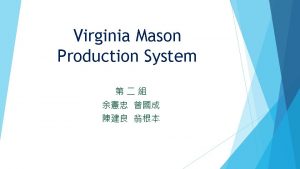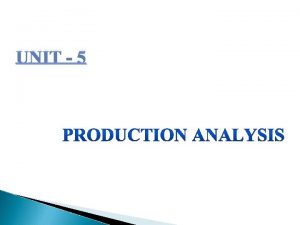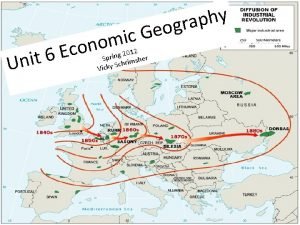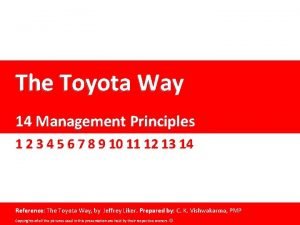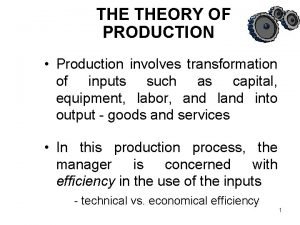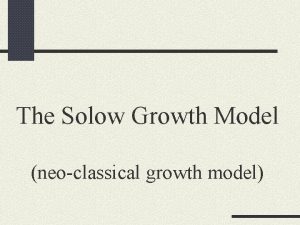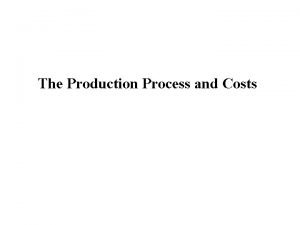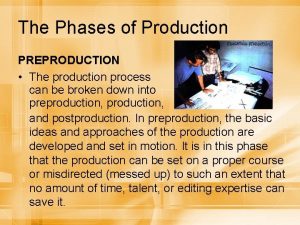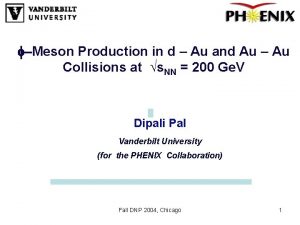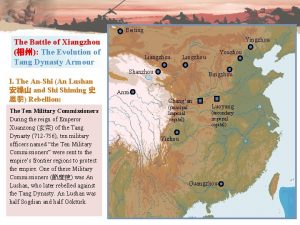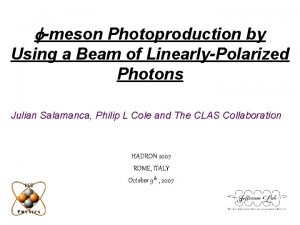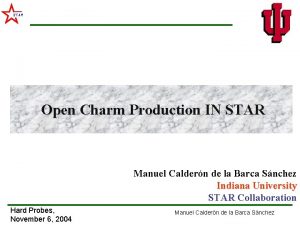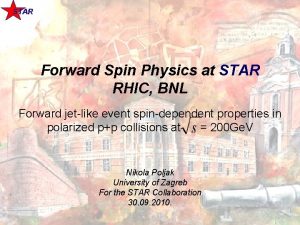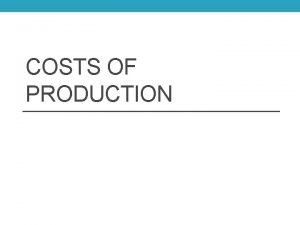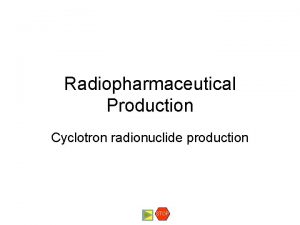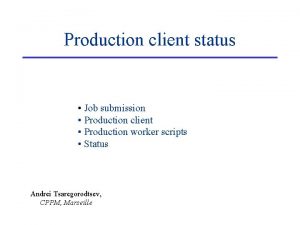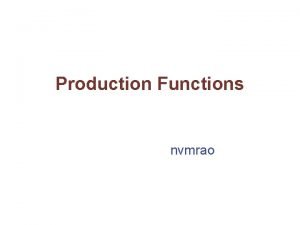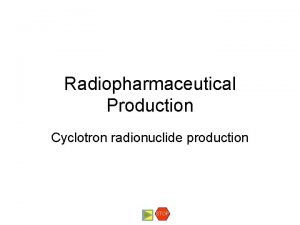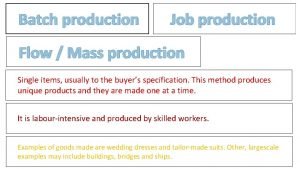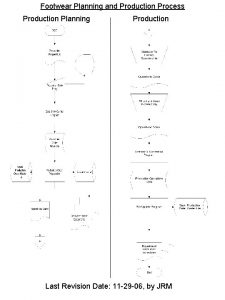STAR Physics with FMeson Production at STAR XiangZhou































- Slides: 31

STAR Physics with F-Meson Production at STAR Xiang-Zhou Cai For China-STAR Collaboration Shanghai INstitute of Applied Physics, CAS Outline • Introduction & Motivations • F results from STAR experiment Ø F Spectra shape and collision energy dependence Ø Ratio of particle yield ( /p, /k, W/ ) Ø Nuclear modification factor: RCP, RAB Ø Elliptic Flow v 2 of F Mesons • STAR-TOF and its meanings to F: Our future expectation STAR To. F Meeting, Hangzhou, Arpril. 27~29, 2009

How about Meson? STAR ØPhi production can be a good probe ØOZI rule suppression vs strangeness enhancement Øsmall cross section for scattering with nonstrange hadrons ØInformation from earlier time before chemical freezeout? ØSensitive to early flow? (Alvarez-Ruso, V. Koch) ØMass shift & width widened due to nuclear medium effect? Asakawa, Ko, Song, NPA 572(1994)732, PLB 388(1996)141 ØProduction mechanism: ggg -> ; s sbar -> ; K+K- -> RQMD predicted an increase of /K- ratio (2/3 phi mesons) Øwhether the particle dependence of the Rcp is dividing by the particle mass or particle type? (Group: , L, Ks) ØElliptic flow: v 2 dependence on particle mass at low p. T dependence on particle type at intermediate p. T Ø Ø m ~ 1019 Me. V/c 2 , ~ 4. 45 Me. V/c 2, t ~ 45 fm/c Vector meson quark content : s, sbar Studied decay channel: K+ K- (49. 6%), e+e-, m+m. STAR To. F Meeting, Hangzhou, Arpril. 27~29, 2009

STAR p Data set of analysis STAR TPC used to identify Kaon via d. E/dx in TPC gas STAR Detector 62. 4 Ge. V Au+Au collision 62. 4 Ge. V Cu+Cu collision 130 Ge. V Au+Au collision 200 Ge. V d+Au collision 200 Ge. V p+p collision 200 Ge. V Cu+Cu collision Can compare the production between different collision energy & collision system 1)d. E/dx identify stable charged particles in a certain momentum range. 2) F meson is reconstructed from K+Kpairs by event mixing method. STAR To. F Meeting, Hangzhou, Arpril. 27~29, 2009

STAR Event-Mixing and d-dip angle cut Event-Mixing technique – Select K+ and K- tracks from PID by energy loss in TPC – Combine all pairs from same event Signal+Background (same event spectra) – Combine pairs from different events Background (mixed event spectra) – Signal = same event spectra – mixed event spectra p d-dip-angle >0. 04 radians p peak from photon conversion background is very effectively removed p It will reduce the reconstruction efficiency by ~12%. STAR To. F Meeting, Hangzhou, Arpril. 27~29, 2009

STAR Invariant mass distribution Event-mixing method used to estimate combinatorial background from uncorrelated K+K- pairs; p After back-ground subtraction, the mass peak can be seen clearly for all data-sets. p Final subtracted minv distribution fitted with Breit-Wigner + linear (or polynomial) background function. p A residual background remains: includeing the real correlated background from decay pairs due to Coulomb interactions and particle decays p STAR To. F Meeting, Hangzhou, Arpril. 27~29, 2009

STAR Masses and widths An interesting excess on the low-mass side of the invariant mass peak was observed in the e++e− channel for 12 Ge. V p+A interactions from the KEK experiment. It indicates a vector meson mass modification at normal nuclear density. PRL 98, 042501, 2007 – p. T> 1 Ge. V/c, mass and width are consistent with those from Monte Carlo (MC) embedding simulations – p. T< 1 Ge. V/c, The mass drop of ~2. 5 Me. V at lower p. T in both real data and simulation is understood within detector effects, which is not fully corrected. – its width is larger than both PDG value and MC simulation, which is due to detector and geometry effect. – this difference limited the sensitivity to probe the possible small modifications of meson properties in the produced medium. – Measurement though the dilepton decay channel are needed with TOF! STAR To. F Meeting, Hangzhou, Arpril. 27~29, 2009

STAR Spectra of and fits STAR Preliminary 1)With efficiency correction (including vertex efficiency). Statistical errors only. 2)Spectra of Au+Au collisions can be described by exponential function while spectra of d+Au and p+p collisions deviate from the exponential distribution and have a power-law tail at intermediate p. T 3)measurements of 200 Ge. V Au+Au collisions at STAR for Run II and Run IV are consistent (1)Exponential shape: (2) Levy shape: The exponential function is the limit of the Levy function as n approaches infinite. STAR To. F Meeting, Hangzhou, Arpril. 27~29, 2009

STAR Spectra of and fits STAR Preliminary – Levy function describe well the data (exponential in central and power-law-like in peripheral) – Similar trend in Cu+Cu and Au+Au at the similar Npart at same collision energy A change in the shape of spectra from p+p, d+Au and peripheral Au+Au collisions to central Au+Au collisions is clearly visible. The change of spectra shape may indicate that different production mechanisms (hydrodynamics, coalescence/recombination, fragmentation and jet quenching mechanisms) is dominating in different kinematic regions and reaction systems. STAR To. F Meeting, Hangzhou, Arpril. 27~29, 2009

STAR Comparison of spectra shapes STAR Preliminary No suppression for d+Au Suppression for Au+Au 1. Nbin normalized yield is suppressed in central Au + Au collisions at 200 Ge. V, while no suppression is visible for d + Au collisions at 200 Ge. V comparing to p+p collisions. Npart/2 normalized yield is enhanced significantly in central Au + Au collisions, which indicates the hot environment created by central Au + Au collisions is in favor of the production of soft Phi mesons. 2. The observed change of spectra shape in our measurement is more likely to be due to the change of these different production mechanisms in different kinetic regions and reaction systems. 2 for Au. Au collision are necessary! Precise measurement. STAR at (m t-m )>3 Ge. V/c To. F Meeting, Hangzhou, Arpril. 27~29, 2009 6)

STAR d. N/dy and <p. T> – the Npart normalized yield d. N/dy increases rapidly and then saturates for mid-central Au+Au collisions. STAR Preliminary –The d. N/dy and <p. T> are similar for Cu+Cu and Au+Au at similar Npart bin for the same collisions energy. – yields from Au+Au and Cu+Cu collisions depend on the number of participant nucleons only, unlike Kaon and hyperons. [1] NA 49 Col. Phys. Rev. Lett. 96, 052301 (2005); [2] E-802 Col. Phys. Rev. C 60, 044904 (1999). STAR To. F Meeting, Hangzhou, Arpril. 27~29, 2009

STAR <p. T > STAR Preliminary <p. T> Teffective <p. T> increases slightly with Npart and energy, seems to saturate at high Npart. It indicates that more higher temperature can be reached in more central and energy collisions. Not in same velocity! STAR Preliminary <p. T> of , Λ, Ξ and Ω do not seem to follow the <p. T> Vs. mass trend which increases with mass for π -, K- and pbar. It is caused by their small hadronic cross section , which may indicate would carry more information about early state. STAR To. F Meeting, Hangzhou, Arpril. 27~29, 2009 8)

STAR Strangeness enhancement: yield relative to p+p X -meson enhancement: K, L STAR Preliminary 200 Ge. V -- between K/L and Xi -- 200 Ge. V data > 62. 4 Ge. V, unlike hyperons -- could not be solely due to the canonical suppression, there could be dynamics effect 62. 4 Ge. V STAR To. F Meeting, Hangzhou, Arpril. 27~29, 2009

STAR Ratios of to π- or K- (1) φ yields increase faster than π- in higher center-of-mass beam energy onset of strange quark degree of the freedom? AA>pp: partonic environment favors φ production? (2) No strong centrality dependence of φ/K- in Au+Au collisions; an underlying production mechanism for phi that is common to all systems. RQMD predicts increasing φ/k- vs Npart, and much smaller than the data. Kaon coalescence could not be a dominant channel of φ-meson production! STAR To. F Meeting, Hangzhou, Arpril. 27~29, 2009 9)

STAR Ratios of W to the mechanisms of (multi)strange particle production are predicted to be very sensitive to the early phase of nuclear collisions, the ratio of W/ is expected to reflect the partonic nature of thermal source. With decreasing centrality, the observed W/ ratios seem to turn over at successively lower values of p. T possibly indicating a smaller contribution from thermal quark coalescence in more peripheral collisions. This is also reflected in the smooth evolution of the p. T spectra shapes from thermal-like exponentials to Levy-like curves. Since -mesons are made via coalescence of seemingly thermalized s quarks in central Au+Au collisions, the observations imply hot and dense matter with partonic collectivity has been formed at RHIC. STAR Col. Phys. Rev. Lett. 99, 112301 (2007). More precise measurement at p. T>3 Ge. V/c are necessary! STAR To. F Meeting, Hangzhou, Arpril. 27~29, 2009

STAR RCP of Run IV: Au. Au 200 Ge. V d. Au 200 Ge. V • Mesons (Ks, K , ) have the similar RCP for d. Au and Au. Au collisions • Baryons (L, X) have the similar RCP too, but higher than mesons. Particle production at intermediate p. T region is divided by the particle’s types, not the masses STAR: behaves like mesons, despite of its large mass favor Recombination/Coalescence model For 0 -5%/60 -80%, it may be attributed to the shape change of spectra from exponential one at (40 -60%) centrality to levy one at (60 -80%) centrality, which may be due to the change of production mechanism in different environments with different degrees of STAR strangeness equilibration. To. F Meeting, Hangzhou, Arpril. 27~29, 2009

STAR RCP of for different collision system STAR Preliminary • yield suppression at intermediate PT in central Au+Au collisions • weak suppression is shown in the 62. 4 Ge. V Au+Au collisions. It becomes flat at PT>1 Ge. V/c • RCP in d+Au collisions is enhanced Low p. T, RCP <1 High p. T, RCP >1 It is difficult to draw some definite conclusions due to the large error bars Measurements of phi meson production in relativistic heavy ion collisions at RHIC B. I. Abelev et al. for STAR Collaboration, submit to PRC STAR To. F Meeting, Hangzhou, Arpril. 27~29, 2009

STAR Nuclear Modification factor STAR Preliminary Comparing central Au+Au and central Cu+Cu with peripheral Au+Au Collisions— 1) the yield and p. T shape depend on number of participants only 2) in terms of number of binary collisons the Cu+Cu data is higher indicating given the same top 10% centrality Cu+Cu has less number of collisions per participant STAR To. F Meeting, Hangzhou, Arpril. 27~29, 2009

STAR Elliptic Flow v 2 Measurements of v 2 from both reaction plane and invariant mass methods are consistent. 1. 2. 3. 4. 5. The phi meson has significantly non-zero v 2 which must have been developed in the earlier partonic stage. In the low p. T region (0» 2 Ge. V/c), v 2 of phi sits in between K 0 S and L, consistent with the expectation of a mass ordering of v 2 in hydrodynamic models. These observations support the hypothesis of development of partonic collectivity and possible thermalization in the early stages at RHIC the elliptic flow of Φ-meson is close to Ks. It indicates that the momentum space anisotropy of constituent quarks (s and s for phi ) is developed prior to hadron formation. The heavier s quarks flow as strongly as the lighter u and d quarks. v 2(p. T) increases with increasing eccentricity (decreasing centrality). the centrality dependence of the <v 2> of the meson is consistent with that of the charged hadrons Error bars in high pt range (2. 5 Ge. V, 5. 0 Ge. V) are still large! STAR To. F Meeting, Hangzhou, Arpril. 27~29, 2009

What STAR we learned from STAR about (1) Did not probe the small modifications of mass in the produced medium. (2) The change of spectra shape may indicate that different production mechanisms is dominating in different kinematic regions and reaction systems (3) The <p. T> of , Λ, Ξ and Ω do not seem to follow the <p. T> Vs. mass trend which increases with mass for π -, K- and pbar. which may indicate would carry more information about early state. (4) The lack of a significant centrality dependence of the /K- effectively rules out kaon coalesence as a dominant production channel for the at RHIC energy. (5) The phi meson has significantly non-zero v 2. It indicates that the heavier s quarks flow as strongly as the lighter u and d quarks. (6) The Rcp and v 2 of the clearly behaves more like the Ks 0 meson than the Λ baryon. Therefore, processes relevant to Rcp and v 2 at intermediate p. T are driven by the type of particle. (7) The transverse momentum spectra in both shape and yields are similar in Cu+Cu and Au+Au for collisions with similar Npart (8) -meson enhancement shows a distinct collision centrality and energy dependence. The enhancement cannot solely due to canonical suppression of strangeness production, there could be dynamics effect. STAR To. F Meeting, Hangzhou, Arpril. 27~29, 2009

STAR Performance of STAR-TOF prototypes φ background suppression Au+Au 200 Ge. V min-bias STAR Preliminary One tray will enhance the S/B ratio by a factor of 3. 5 at intermediate p. T. § TPC+TOF: Ø Pion: 0. -~12 Ge. V/c Ø Kaon: 0. 2 -~3 Ge. V/c Ø Proton: 0. 2 -~5 Ge. V/c Full barrel ~ a factor of 10. Reduce the error bar Extend the measurement into high PT TOF+TPC : one kaon from φ identified by TPC, the other by TOF TPC+TPC : the 2 kaons from φ identified using only TPC STAR To. F Meeting, Hangzhou, Arpril. 27~29, 2009

STAR What we can expect for further study of meson with full-TOF? With TOF, We can: 1、Reconstruct from di-lepton decay channel 2、Extend the measurement into high p. T region 3、Increase the S/B ratio, reduce the background Focus on the relative physical topics: 1、Compare the production of from both hadron and lepton decay channel with large acceptance. To answer the puzzle (in-medium effects on and kaons + kaon absorption and rescattering leading to reduced yield and hardened p. T spectrum in hadronic channel? ) 2、Is there any medium effect (Mass shift & width widened) at RHIC collision? 3、Study the centrality dependence of Ratios of N(W)/N( ). Probe the property of thermal source? 4、Measure the spectra shapes at high p. T region to see the yield suppression. 5、Energy dependence of production. (under STAR the energy scan plan) To see when the value of v 2 of will be small or zero. ……………… STAR To. F Meeting, Hangzhou, Arpril. 27~29, 2009

STAR Backup STAR To. F Meeting, Hangzhou, Arpril. 27~29, 2009

PID STAR TPC alone TOF “alone” k p TOF=110 ps TPC alone PID range: pi/k ~0. 6 Ge. V/c, (pi, k)/p ~1. 6 Ge. V/c; TOF “alone” PID range: pi/k ~1. 6 Ge. V/c, (pi, k)/p ~ 3. 0 Ge. V/c m 2 STAR To. F Meeting, Hangzhou, Arpril. 27~29, 2009 m 2

STAR PID hadrons (TPC + TOF) Low & intermediate p. T High performance of time resolution PID 0. 15 - 4 Ge. V/c TPC High p. T Relativistic rising of d. E/dx PID up to 12 Ge. V/c STAR To. F Meeting, Hangzhou, Arpril. 27~29, 2009 2. 5<p. T<3. 0

Electron identification STAR Lepton decay from heavy quark Electorns mixed with pions if only d. E/dx of TPC is used to identify particles Combined with TOF,electrons can be separated from pions cleanly X. Dong, Z. B. Xu, LJ Ruan, J Wu (USTC-BNL) et al STAR To. F Meeting, Hangzhou, Arpril. 27~29, 2009

STAR -meson production from Au+Au <p. T> /K- 1. <p. T>, -meson decoupled early; 2. N( )/N(K), ruled out the K-coalescence; 3. Evolution in the centrality dependence; STAR Col. Phys. Lett. B 612, 181 (2005), Phys. Rev. Lett. 99, 112301 (2007). Cu+Cu collisions provide unique data to further probe these features. STAR To. F Meeting, Hangzhou, Arpril. 27~29, 2009

STAR N( )/N(p) – A decreasing trend in N( )/N(p) vs. p. T would be an unambiguous signature for early decoupling of mesons from the hadronic rescattering dynamics[1] – Fitting with Hirano’s model[1] yield: [1] Hydro calculation: ar. Xiv: 0710. 5795 v 1 – p+p, Chi. Square/ndf = 6. 01/8 – Au+Au w rescattering, Chi. Square/ndf = 11. 42/8 – Au+Au w/o rescattering, Chi. Square/ndf = 29. 14/8 – Au+Au, Tth=100 Mev, Chi. Square/ndf = 7. 75/8 STAR To. F Meeting, Hangzhou, Arpril. 27~29, 2009

STAR Particle-type dependence of RCP & v 2 PHENIX: PRL 91, 182301(03) STAR: PRL 92, 052302(04) nucl-ex/0306007 Models: Greco et al, PRC 68, 034904(03) 200 Ge. V Au+Au Baryon Meson 1) RCP suppression of Au. Au collisions at intermediate PT. 2) Particle type dependence of RCP from Au+Au collisions has been observed. 3) The particle type dependence of the RCP at intermediate p. T in Au. Au collisions can be explained by Recombination/Coalescence model R. C. Hwa et al. University of Oregon C. M. Ko et al. Texas A&M R. J. Fries et al. Duke/Minnesota QB Xie et al. , Univ. of Shan. Dong …… STAR To. F Meeting, Hangzhou, Arpril. 27~29, 2009

STAR Saturation at intermediate p. T Baryon and meson difference -Constituent Quark Number Scaling Hydrodynamic model can describe data well at low p. T by assuming a local thermal equilibrium of partons. the intermediate p. T range may be described by Re. C/Coalescence model STAR To. F Meeting, Hangzhou, Arpril. 27~29, 2009

STAR Compared results on the invariant mass methods Under the assumption that the background contribution to v 2(minv) (the second part on right side of equation) is smooth as a function of minv, a polynomial function was used to parameterize the background v 2 vs. minv by fitting v 2 vs. minv distributions in each p. T bin. N. Borghini and J. Y. Ollitrault, PRC 70(2004) 064905 STAR To. F Meeting, Hangzhou, Arpril. 27~29, 2009

STAR Strange quark dynamics: Why the φ-meson ? The medium produced in HI collisions is very shortlived → we need probes which carry information from the early stage to find out about the medium constituents: K- K+ K+ K- The φ(s-sbar) is a clean probe from early time: – Small σ for interactions with non-strange particles – Relatively long-lived (41 fm/c) → decays outside the fireball – Previous measurements have ruled out K+Kcoalescence as φ production mechanism → info not “diluted” by hadronic phase φ QGP φ The φ can provide info on particle production mechanisms / medium constituents: – The φ is a meson but as heavy as Λ, p baryons – Differentiate between mass-type or meson/baryontype dependencies The clean φ is a good probe to understand the strange quark properties, transverse momentum dis. or spin orientation… φ KK+ STAR To. F Meeting, Hangzhou, Arpril. 27~29, 2009
 Contoh diagram alir proses produksi
Contoh diagram alir proses produksi Bearing gifts we traverse afar
Bearing gifts we traverse afar Modern physics vs classical physics
Modern physics vs classical physics University physics with modern physics fifteenth edition
University physics with modern physics fifteenth edition Ib physics ia ideas
Ib physics ia ideas Ao* algorithm
Ao* algorithm Fccla star events
Fccla star events Mass communication
Mass communication Cased hole services
Cased hole services Laryunx
Laryunx Virginia mason production system
Virginia mason production system Vegetable production introduction
Vegetable production introduction Production area drama
Production area drama Major engineering problems in urea production
Major engineering problems in urea production Management myths in software engineering
Management myths in software engineering A fixed input
A fixed input Lean production and quality management
Lean production and quality management Unit 4 pre-production portfolio example
Unit 4 pre-production portfolio example Stages of film production
Stages of film production Blue banana
Blue banana Flow production examples
Flow production examples Toyota way 14 principles
Toyota way 14 principles Stages of production in the short run
Stages of production in the short run Production sheets food service
Production sheets food service Aggregate production function
Aggregate production function Production analysis
Production analysis Garrett model of speech production
Garrett model of speech production Phases of production
Phases of production Math is not an essential skill for foodservice managers.
Math is not an essential skill for foodservice managers. Multi camera production
Multi camera production Television production team
Television production team Arytnoids
Arytnoids










